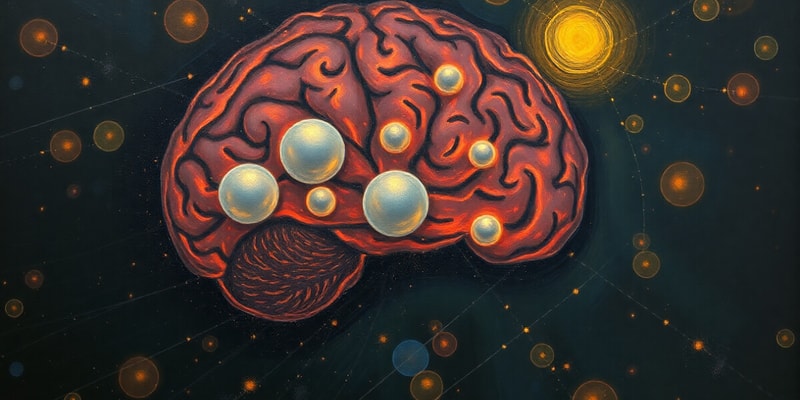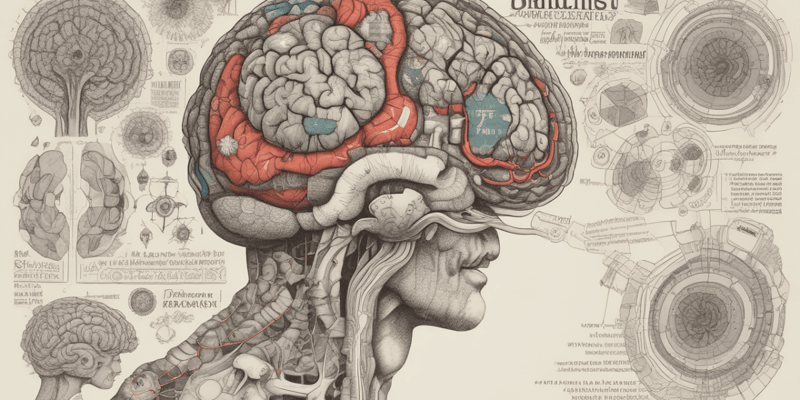Podcast Beta
Questions and Answers
What is the frontal lobe primarily responsible for?
Which two structures make up the limbic system?
What does the computational model of the mind suggest about cognition?
What is the primary function of the sensory cortex?
Signup and view all the answers
What does parallel distributed processing indicate about brain functions?
Signup and view all the answers
Which of the following is a limitation of the experimental method?
Signup and view all the answers
The occipital lobe is primarily responsible for processing which type of information?
Signup and view all the answers
What is the main role of the hippocampus in the brain?
Signup and view all the answers
What is the primary purpose of sensation in the context of sensory processing?
Signup and view all the answers
Which object perception model focuses on the flexibility of recognizing objects based on templates?
Signup and view all the answers
What is the main limitation of the feature analysis model?
Signup and view all the answers
In Artificial Neural Networks, what do the weights between nodes represent?
Signup and view all the answers
How is the final output produced in an artificial neural network?
Signup and view all the answers
What process is used to train multilayered neural networks?
Signup and view all the answers
Why might adding more hidden layers to a neural network be detrimental?
Signup and view all the answers
What is the first layer of nodes in an artificial neural network designed to do?
Signup and view all the answers
What does monism (materialism) claim about existence?
Signup and view all the answers
What is dualism in relation to the mind-body problem?
Signup and view all the answers
What is the main premise of the Physical Symbol System hypothesis?
Signup and view all the answers
What does the Chinese room argument illustrate regarding understanding?
Signup and view all the answers
What is the Turing Test designed to assess?
Signup and view all the answers
What does the global workspace theory propose?
Signup and view all the answers
What does functionalism focus on in mental states?
Signup and view all the answers
Which of the following is NOT a viewpoint related to the mind-body problem?
Signup and view all the answers
What is the role of the right inferior frontal cortex in ADHD treatment?
Signup and view all the answers
How does sleep deprivation affect cognition?
Signup and view all the answers
What is biofeedback used to treat?
Signup and view all the answers
What is the primary function of the glymphatic system during sleep?
Signup and view all the answers
What is a possible consequence of adolescents experiencing sleep deprivation?
Signup and view all the answers
Which type of processing may TV reliance contribute to attention problems?
Signup and view all the answers
The basic rest-activity cycle refers to what?
Signup and view all the answers
When are most dreams experienced during sleep?
Signup and view all the answers
What is the primary basis of phenomenal consciousness?
Signup and view all the answers
What does split brain research indicate about consciousness?
Signup and view all the answers
What is anosognosia?
Signup and view all the answers
Who is more likely to be susceptible to hypnosis?
Signup and view all the answers
What is one potential use of hypnosis?
Signup and view all the answers
What does MDMA primarily do in the brain?
Signup and view all the answers
What are the negative effects associated with psilocybin use?
Signup and view all the answers
What is a common effect of LSD?
Signup and view all the answers
Study Notes
Computational Model of Mind
- Cognition involves an algorithmic process of information processing.
- The brain performs a range of activities simultaneously, and can complete information processing even if some information is missing or incorrect.
- This model explains how the mind can be understood in terms of computational processes.
Brain and Cognitive Functions
- Frontal lobe: Speaking, muscle movement, planning and judgment.
- Parietal lobe: Sensory cortex.
- Occipital lobe: Visual information.
- Temporal lobe: Auditory information.
- Motor cortex: Voluntary movements.
- Sensory cortex: Sensations.
Limbic System
- Divided into two parts: amygdala and hippocampus.
- Amygdala: Involved in emotions, fear, and aggression.
- Hippocampus: Responsible for memory.
Experimental Method Limitations
- Lack of Ecological Validity: Controlled environments are less realistic than real-life situations.
- Limited Scope: Many important aspects of life cannot be easily quantified or measured.
- Confounding Variable Effects: Beliefs and expectations can influence outcomes of experiments.
Sensation and Perception
- Sensation: Sensory receptors and the nervous system convert stimuli into neural impulses.
- Perception: Sensory information is interpreted and organized using existing knowledge.
Early Models of Object Perception
- Template Matching: Recognition occurs by matching the perceived object to an internal "template" in memory.
- Feature Analysis: Recognition involves detecting specific features of objects, which then activate corresponding representations in the brain.
- Prototype: Recognition is based on a "prototype" or ideal representation of the object, with variations accepted within certain boundaries.
- Recognition-by-Components (RBC): Recognition involves breaking down objects into basic 3D components (geons).
Template Matching Problems
- Fails to account for complex objects and variations due to factors like changes in perspective or viewing angle.
Feature Analysis Problems
- Difficulty recognizing complex objects that have many moving features.
Artificial Neural Networks
- Neurons: Represented by "nodes" in the network.
- Weights: Connections between nodes, analogous to inhibitory postsynaptic potentials (IPSPs) and excitatory postsynaptic potentials (EPSPs).
- Activation: Nodes are activated based on the weighted sum of inputs. A grey scale represents activation, with 0 being no activation and 1 being fully activated.
- Layer Processing: The network processes information through multiple layers, extracting features and making decisions at each stage.
- Output: The network's output is the node with the highest activation in the final layer, representing the "answer."
Multilayered Neural Networks Training
- Back Propagation: The weights between nodes are adjusted based on the difference between the network's output and the desired output (the "error signal").
ADHD and Cognitive Performance
- There is a positive correlation between ADHD symptoms and task performance.
- Children with ADHD who wiggle and fidget during tasks can actually perform better on cognitive tests.
Biofeedback
- Individuals learn to control autonomic functions, such as heart rate and breathing, through feedback about their physiological responses.
Neurofeedback
- Uses devices like EEG or fMRI to provide feedback about brain activity, aiming to modify behavior.
- EEG neurofeedback measures brainwave activity.
Neurofeedback and ADHD
- fMRI neurofeedback enhances activity in the right inferior frontal cortex, which can improve symptoms of ADHD.
TV Viewing and Attention
- Excessive TV viewing can lead to attention problems due to reliance on bottom-up processing:
- Externally generated attention is prioritized over internal focus.
Sleep Deprivation Effects
- Prefrontal Cortex: Impairs attention, memory, and decision making.
- Memory Impairment: Difficulty forming and retrieving memories.
- Cognitive Flexibility: Reduced ability to adjust to new information and tasks.
- Connections and Integration: Difficulties making broad connections between concepts.
Sleep Deprivation in Adolescents
- Increased risk of developing health problems like high blood pressure, heart disease, diabetes, depression, and car accidents.
- Sleep Debt: Accumulated lack of sleep.
Neurophysiological Functions of Sleep
- Memory Consolidation: Sleep plays a crucial role in transferring memories from short-term to long-term storage.
- Restoration: Provides an opportunity for the body to regenerate and repair itself.
- Glymphatic System: During sleep, the glymphatic system flushes toxins from the brain, promoting brain health.
Glymphatic System during Sleep
- Cerebrospinal fluid is pushed through the brain to eliminate damaging molecules.
Basic Rest-Activity Cycle
- Sleep follows a 90 minute cycle of autonomic activities, characterized by shifts in brainwaves.
Dreams
- Primarily occur during REM sleep (rapid eye movement) but also in NREM (non-rapid eye movement).
Theories of Dreams
- While multiple interpretations exist, dreams may provide insights into unconscious thoughts, process emotions, consolidate memories, or simply reflect random neural activity.
Mind-Body Problem Viewpoints
-
Monism: Sees the mind and body as a single entity.
- Idealism: Everything is fundamentally mental.
- Materialism: Everything, including the mind, is physical.
- Dualism: The mind and body are distinct and separate.
- Functionalism: The nature of a mental state is determined by its causal role in relation to inputs and outputs.
Physical Symbol System Hypothesis
- Intelligence is based on the manipulation of symbols.
- Machines can be intelligent if they utilize a physical symbol system.
- Humans are intelligent because their minds are a physical symbol system.
PSS and Thinking
- Thinking is considered to be the manipulation of symbols.
- The same symbol system can be implemented on a computer or in the human mind.
Chinese Room Argument
- Argues that simulating understanding of Chinese does not necessarily equal true understanding.
- Questions the PSS hypothesis by suggesting a computer manipulating symbols is not equivalent to true understanding.
Turing Test
- A machine is considered intelligent if it can pass the Turing Test.
- The test involves evaluating a machine's ability to engage in a conversation indistinguishable from a human.
Neural Correlates of Consciousness (NCC)
- Brain activity is considered to be the physical basis for consciousness.
- The question remains: Which specific neurons and their coordinated activity are responsible for consciousness?
NCC Theories
- Global Neuronal Workspace Theory: Consciousness arises from the exchange and integration of neural signals within a global workspace.
- Integrated Information Theory: Consciousness is a measure of the complexity and integration of information processing in the brain.
Split Brain
- Studies of split-brain patients, where the corpus callosum is severed, suggest that consciousness is linked to the left hemisphere's verbal mechanism during processing.
Anosognosia
- A neurological disorder where individuals lack awareness of their own deficits.
Hypnosis
- Increased susceptibility to hypnosis is often associated with traits like rich fantasy life and imagination.
Hypnosis Applications
- Memory Retrieval: Hypnosis has been used to uncover repressed memories, though this practice remains controversial.
- Treatment of Physical Disorders: May help manage pain and symptoms of certain disorders.
- Pain Control: Hypnobirthing utilizes hypnosis to manage pain during childbirth, targeting the anterior cingulate and prefrontal cortex.
Hidden Observer in Hypnosis
- There is a dissociated part of the hypnotized individual that remains aware of what is happening, even if the person is no longer consciously experiencing it.
Hallucinogens
- Hallucinogens can produce a variety of effects, including altered perceptions, thoughts, and feelings.
- Examples include LSD, MDMA, and psilocybin.
LSD Effects
- Serotonin and Dopamine: Stimulates serotonin and dopamine receptors.
- Possible Benefits: Can reduce anxiety and dissolve boundaries between the self and the world.
- Potential Risks: Can induce panic attacks, flashbacks, and psychotic episodes.
MDMA Effects
- Neurotransmitter Release: Releases serotonin, norepinephrine, and dopamine, and blocks their reuptake.
- Possible Benefits: Emotional elevation and potential therapeutic applications for PTSD treatment.
- Potential Risks: Dehydration, overheating, damage to serotonin production, and consequent depression and memory impairments.
Psilocybin Effects
- Serotonin Receptor Stimulation: Activates serotonin receptors.
- Possible Benefits: Euphoria, spiritual experiences, and vivid hallucinations.
- Potential Risks: Nausea, panic attacks, and psychotic episodes.
Anterior Cingulate Cortex Function
- Plays a role in a range of cognitive functions, including attention, decision making, and emotional processing.
- Involved in pain perception and regulation.
- The anterior cingulate cortex is connected to various brain regions, allowing it to integrate information from different sources.
Studying That Suits You
Use AI to generate personalized quizzes and flashcards to suit your learning preferences.
Related Documents
Description
This quiz explores key concepts in cognitive neuroscience, including the computational model of the mind, brain structure and functions, and the role of the limbic system. Understand how these elements interact within cognitive processes and their experimental limitations.




